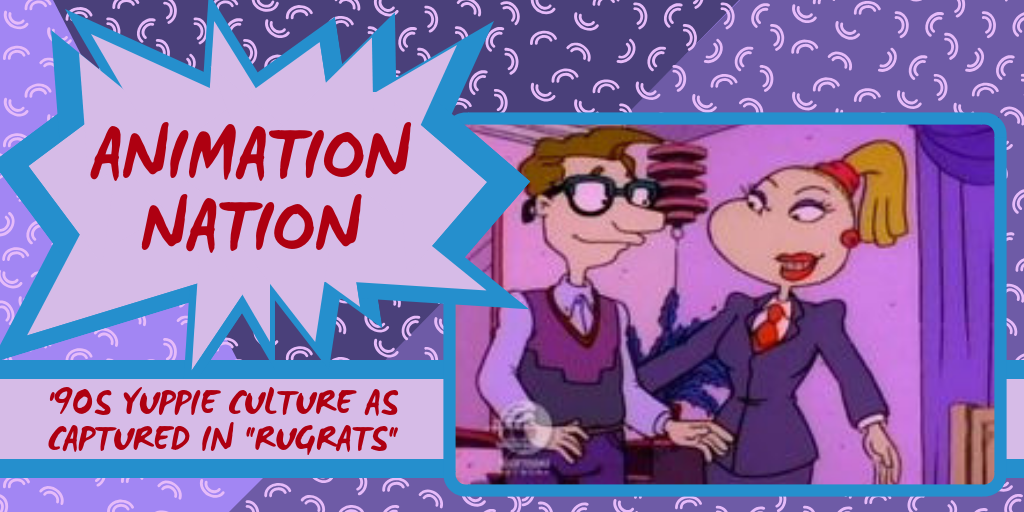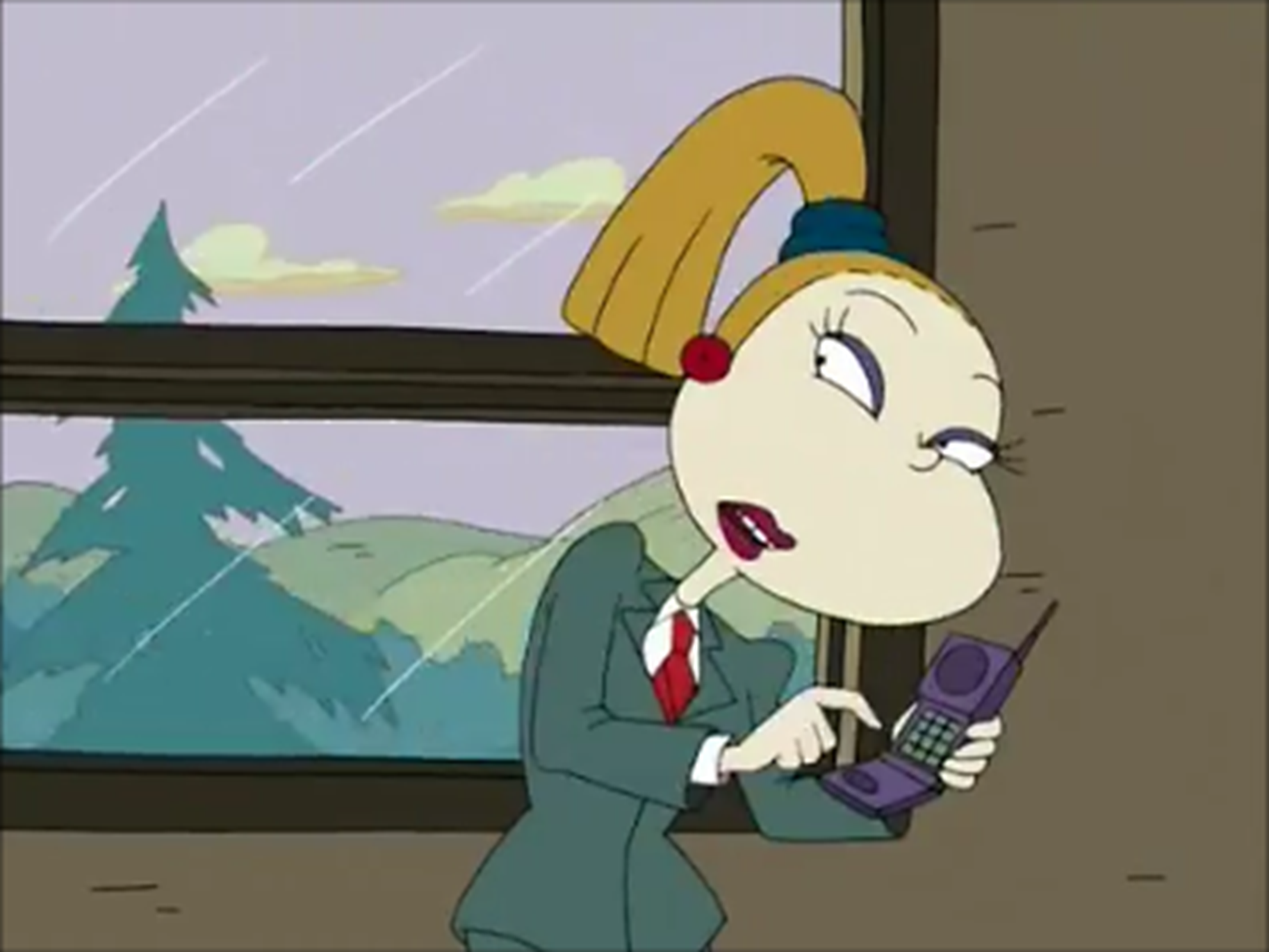Welcome to Animation Nation, a new column on JUST ADD COLOR. In each Animation Nation article, I’m indulging my love of the art of animation by dicussing favorite characters and films, racial and social issues addressed in animation, animation as a time capsule, and general musings on the cartoons of my childhood.
For the first entry in Animation Nation, I figured it makes sense to discuss the show that inspired my header design, Rugrats.
In actuality, Rugrats was never my favorite show; it might be considered sacrilege to say that I liked its sequel series All Grown Up! better since Tommy, Chuckie, Phil, Lil, Angelica, Suzie, Dil and Kimi could actually deal with problems I could relate to. Yes, their imagination as babies was cool and I appreciate the show for attempting to show what life must be like from a baby’s perspective, but I just couldn’t get into it. Also, Angelica was too insufferable for me.
However, it is Angelica that inspired this post. More to the point, Angelica’s parents, Charlotte and Drew, were two in a small group of characters who interested me the most (the others being Chuckie, his poor, sweet dad Chas, and of course Susie, since she routinely provided the perspective I grew up with in my household). When I would watch Rugrats, I’d be particularly mindful of Drew, an investment banker, and Charlotte, a self-made CEO, and how they represented a type of person who rose to power in the 1980s and finally began to lose hold once the early ’90s came around–the Yuppie.
I was born in 1988, so I don’t remember much of anything of yuppie culture from the actual ’80s. But I do remember the yuppies of the early ’90s. Maybe it was through the osmosis of watching TV, but somehow the early ’90s yuppie mentality was baked into me to such a degree that I didn’t realize I had it until I got to my current age. Somehow, I thought it would be easy to attain everything the yuppie had, such as a cell phone (a big thing back in the day, both figuratively and literally), snazzy clothes, power and prestige. I thought I would know what it would feel like to finally “make it.” I thought that even though I live in Alabama and never had any real affinity for living far away from my parents, that somehow I’d be living it up in New York City, catching the taxi, holding my briefcase, getting coffee and living the complete dream life.
But adulting is clearly much harder than it actually is. When you’re a kid, it seems easy to be an adult; it seems like everything just comes to adults. But that’s not the case at all. Trying to be an adult period is hard, but trying to be a yuppie on top of it is even harder. You’ll always be keeping up with the Joneses no matter how much money or prestige you get. You will always be on a hamster wheel. This is definitely what Drew and Charlotte were dealing with whenever they left Angelica at her aunt and uncle’s house while they wheeled and dealed. In the grand scheme of things, you could easily say all that wheeling and dealing was for nothing, because the neglected the thing that should have given them the most pride: being actual parents. This isn’t denigrating working parents, to be clear. BUT, because Drew and Charlotte in particular were so focused on their careers and still obsessed with living the late ’80s yuppie life, they forgot that they actually have to teach their daughter things like morals and manners and humility. Instead, they raised a brat.
However, while I could blame Drew and Charlotte for their lack of parenting, the apple doesn’t fall far from the tree. While her parents’ lack of oversight led to Angelica developing the worst of child tendencies, she’s also completely like her parents in that she craves power. Instead of being kind and nurturing to her baby cousin Tommy and his little baby friends, she lords over them, pretending to know everything just because she happens to be in preschool and they’re still in diapers. The humorous catch, of course, is that she knows nothing–she’s a pampered three-year-old with well-to-do parents who can buy her whatever she wants. It’s only when Susie comes into the picture that Angelica finally has someone who can go toe-to-toe with her. In Susie, the babies finally have a champion that they could have had in Angelica.
To get back to Angelica’s parents, Rugrats always piqued my interest as an animation lover not because of its stories, but because of its ability to act as a time capsule for the early ’90s. As a show made in 1990, it captured all aspects of the decade, particularly when it came to how the adults were products of their time, filling the archetypal roles common in 1990s media. Tommy and Dil’s parents Didi and Stu are both of the mold of people filled with that hard-to-describe ’90s quirkiness that existed in characters like Phoebe from Friends and the entire cast of Blossom. Phil and Lil’s mom Betty is a second-wave feminist. Chuckie’s dad Chas is definitely the Rick Moranis type. And, as we’ve already established, Drew and Charlotte are typical yuppies, obsessed with making more money than they actually need.
The show’s inclusion of the yuppie lifestyle inadvertently captures another trend occurring in the 1990s–the decline of yuppies. Yuppie mentality is something that has endured regardless of what it’s called nowadays, but the cultural fascination with the yuppie began to wane away once I got in kindergarten in 1993. People weren’t yuppies anymore; they were just “businesspeople.”
Interestingly enough, The Washington Post posted one of their internal memos from the ’90s on its website. Called “Yuppies: An Aging Trend,” Richard Leiby, the cultural trends reporter at the time, wrote in 1994, “In most quarters, the yuppie has been falling from favor–ever since 1987, the year the proto-anti-yuppie movie ‘Wall Street’ was released, and the word became a synonym for ‘scum-sucking little greedhead.’ In late 1989, cartoonist Matt Groening placed ‘yuppie’ and ‘yupster’ on his ‘Forbidden Words of the 1990s’ list.
“But something even more powerful was warring against the yuppie: Many reporters began to focus on the new baby boom, the return of couples to the suburban nest, the mini-van and coupon-clipping social trend stories of the ’90s,” he wrote.
In his memo, Leiby also highlighted how the “yuppie” was made up in the first place, quoting Brad Edmonson, the chief of American Demographics magazine at the time, who said, “The yuppie was a fiction to begin with. The main place yuppies existed was in newsrooms. It was a classic story of editors looking at their friends and creating a social trend. It had nothing to do with what was going on in the United States. It had to do with magazines and newspapers needing to fill feature space.”
Leiby wrote, “In the mid-1980s, he says, maybe 1.5 percent of American adults were yuppies–that is, under age 54, residing in an urban area, and affluent (earning more than $40,000). ‘Less than one in 50 adults met that criteria. If you had to define them as professional, it was even less.'”
Leiby wrote that Edmondson said of the yuppie, “This media fiction really resonated with people who wanted to be acquisitive and affluent. But nobody really had the money to live the way yuppies lived.” The only people who possibly could were, as Leiby wrote, “high-powered Washington and New York media-political-legal circles, the same ones who now complain that $150,000 a year is barely enough to make the mortgage and pay the nanny, let alone private school tuitions. You know those types.”
One of the conclusions Leiby came to in his memo was to destroy the yuppie and call them something more applicable.
“We can’t call them yuppies anymore, because they are no longer, technically, young. And they don’t have enough money to afford those overpriced rehabbed urban spaces…So lets call them…Sappies. Suburban Aging Professionals.”
“I look around my neighborhood and the newsroom and see them. They have turned away from the material values of the ’80s and invested their money and time in their children. They may shop at Fresh Fields and drink Starbucks coffee–vestigal yuppie behaviors–but they’ve become more spiritual, less jogging-oriented, more centered on what really matters.”
Leiby probably never watched Rugrats, but the memo is a damning indictment of the type of lives Drew and Charlotte were busting their butts and damaging their lives to try to live. The yuppie is just a made-up trend that can easily proliferate the media and turn impressionable minds like mine towards the glitz of the yuppie lifestyle. A lot of us in the ’80s and early ’90s were swayed into thinking that that type of life was not only attainable, but in excess around us, when in actuality, most people were regular middle-class folks trying to get by. In fact, my own mother fell into the couponing trend of the ’90s to the point that newspaper collecting and coupon-cutting became household games. And, like most ’90s families, we eventually upgraded from our old ’80s Nissan Sentra sedan to a late-’90s Mercury Villager minivan. Even though I had yuppie aspirations, thinking my family was well-to-do but still “poor,” we were actually the typical ’90s family. Most families weren’t Drew and Charlotte. Most families were more like the other families in Rugrats.
Drew and Charlotte, on the other hand, were chasing a dream that was hard to attain and even harder to keep. Not only that, but they were chasing a dream most people in their age group had already grown out of. The rest of the parents were more like “sappies”–living in the suburbs, caring more about their kids than prestige built on shaky ground. Didi, for instance, was a home economics teacher during the original run of Rugrats, but she still indulged in a very yuppie concept of inviting a child psychologist, the quack Dr. Lipschitz, into her home to ask questions about child-rearing. Apparently Chas was originally a bureaucrat–a high-powered position–before becoming a coffee shop owner. The adult friendgroup on Rugrats were very much within the sappie definition. Meanwhile, Drew and Charlotte are still living the lives they probably lived in their 20s, bustling about instead of settling down. Even though they might have more business acumen than their friends, they are in arrested development.
In a lot of ways, Drew and Charlotte are sad individuals who can’t let go of their youth. As we see in All Grown Up!, Charlotte can’t come to terms with getting older and compensates by getting plastic surgery. She’s also still trying to live the same yuppie life she lived as a younger woman, another sign of Charlotte’s inability to grow up. It’s as if she’s morphed into Patsy from Absolutely Fabulous. In some ways, maybe she always was Patsy, but just carried a briefcase instead of a cigarette.
I think I’ve written enough on Drew and Charlotte. Somewhere in the back of my mind, I always wished they would find peace as parents and actually spent time with their daughter instead of constantly chasing money. Maybe Angelica would have turned out better and perhaps, maybe spending time with Angelica would force them as parents to mature with her.

